Identifying Nutrient Export Hotspots Using a Spatially Distributed Model in Boreal-Forested Catchments
Abstract
1. Introduction
- i
- How much does the nutrient export vary according to the location of the clear-cuts, on catchment and sub-catchment scales, and by how much can the nutrient export be reduced by changing the locations of clear-cuts, while keeping the total clear-cut area constant?
- ii
- What is the importance of the background export in the total nutrient export, and what are the most influential sub-catchment characteristics regulating the background load?
- iii
- How can nutrient export hotspots be identified, mapped and used in the water protection planning process?
2. Materials and Methods
2.1. Study Area
2.2. NutSpaFHy Model
2.3. Input Data
2.4. Clear-Cut Scenarios
2.5. Data Analysis
3. Results
3.1. Clear-Cut-Induced Nutrient Export
3.2. Background Export
3.3. Nutrient Export Hotspots
4. Discussion
4.1. Impact of Clear-Cut Location on Nutrient Export, on Catchment and Sub-Catchment Scales
4.2. Background Export
4.3. Hotspots
4.4. Implementing Results in the Water Protection Planning Process
5. Conclusions
Author Contributions
Funding
Institutional Review Board Statement
Informed Consent Statement
Data Availability Statement
Acknowledgments
Conflicts of Interest
Appendix A. Catchment Characteristics Correlations with TN and TP Export

Appendix B. Clear-Cut Sites’ Location-Specific Impact on Nutrient Export in 100 Clear
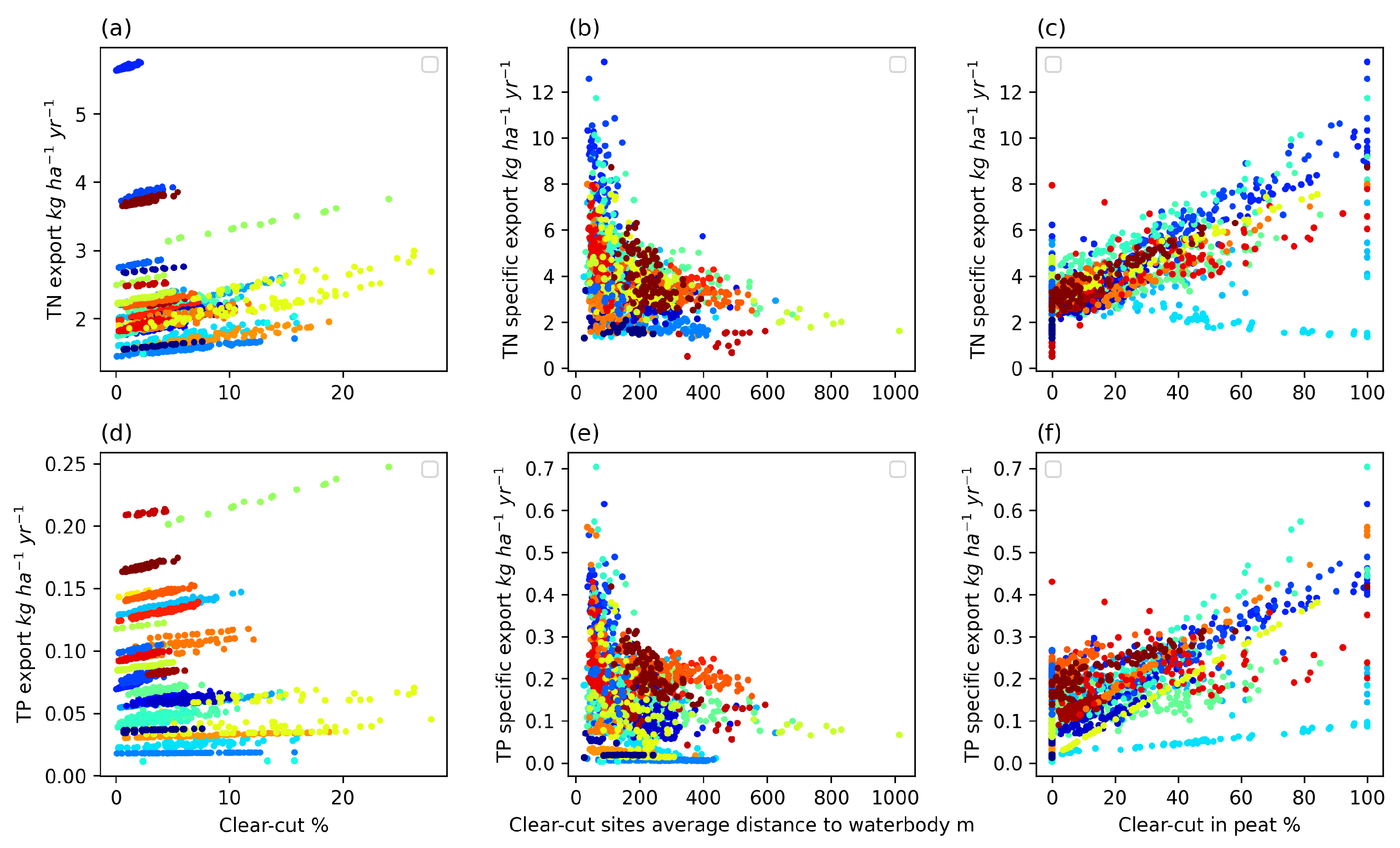
References
- WFD. Water Framework Directive. Directive 2000/60/EC of the European Parliament and the Council of 23 October 2000 establishing a framework for community action in the field of water policy. Off. J. Eur. Communities 2000, 327, 1–73. [Google Scholar]
- Carvalho, L.; Mackay, E.B.; Cardoso, A.C.; Baattrup-Pedersen, A.; Birk, S.; Blackstock, K.L.; Borics, G.; Borja, A.; Feld, C.K.; Ferreira, M.T.; et al. Protecting and restoring Europe’s waters: An analysis of the future development needs of the Water Framework Directive. Sci. Total. Environ. 2019, 658, 1228–1238. [Google Scholar] [CrossRef] [PubMed]
- Luke, N.R.I.F. Finnish Statistical Yearbook of Forestry 2021. 2021. Available online: https://www.luke.fi/en/statistics/about-statistics/statistical-publications/finnish-statistical-yearbook-of-forestry (accessed on 31 July 2022).
- Palviainen, M.; Finér, L.; Laurén, A.; Launiainen, S.; Piirainen, S.; Mattsson, T.; Starr, M. Nitrogen, Phosphorus, Carbon, and Suspended Solids Loads from Forest Clear-Cutting and Site Preparation: Long-Term Paired Catchment Studies from Eastern Finland. Ambio 2014, 43, 218–233. [Google Scholar] [CrossRef] [PubMed]
- Lepistö, A.; Räike, A.; Sallantaus, T.; Finér, L. Increases in organic carbon and nitrogen concentrations in boreal forested catchments—Changes driven by climate and deposition. Sci. Total. Environ. 2021, 780, 146627. [Google Scholar] [CrossRef]
- FFC, F.F.C. Open Forest and Nature Information. 2022. Available online: https://www.metsakeskus.fi/en/open-forest-and-nature-information (accessed on 9 July 2022).
- Kreutzweiser, D.P.; Hazlett, P.W.; Gunn, J.M. Logging impacts on the biogeochemistry of boreal forest soils and nutrient export to aquatic systems: A review. Environ. Rev. 2008, 16, 157–179. [Google Scholar] [CrossRef]
- Tamm, C.O. Nitrogen in Terrestrial Ecosystems: Questions of Productivity, Vegetational Changes, and Ecosystem Stability; Springer: Berlin/Heidelberg, Germany, 1991. [Google Scholar]
- Laurén, A.; Finér, L.; Koivusalo, H.; Kokkonen, T.; Karvonen, T.; Kellomäki, S.; Mannerkoski, H.; Ahtiainen, M. Water and nitrogen processes along a typical water flowpath and streamwater exports from a forested catchment and changes after clear-cutting: A modelling study. Hydrol. Earth Syst. Sci. 2005, 9, 657–674. [Google Scholar] [CrossRef]
- Sponseller, R.A.; Gundale, M.J.; Futter, M.; Ring, E.; Nordin, A.; Näsholm, T.; Laudon, H. Nitrogen dynamics in managed boreal forests: Recent advances and future research directions. Ambio 2016, 45, 175–187. [Google Scholar] [CrossRef]
- Grip, H. Water Chemistry and Runoff in Forest Streams at Kloten; UNGI Rapport; UNGI: Stockholm, Sweden, 1982. [Google Scholar]
- Ahtiainen, M. Avohakkuun ja Metsäojituksen Vaikutukset Purovesien laatuun; Vesi-ja Ympäristöhallinnon Julkaisuja. Sarja A, 45; Vesi-ja Ympäristöhallitus: Helsinki, Finland, 1990. [Google Scholar]
- Ahtiainen, M. The effects of forest clear-cutting and scarification on the water quality of small brooks. Hydrobiologia 1992, 243–244, 465–473. [Google Scholar] [CrossRef]
- Rosén, K.; Aronson, J.A.; Eriksson, H.M. Effects of clear-cutting on streamwater quality in forest catchments in central Sweden. For. Ecol. Manag. 1996, 83, 237–244. [Google Scholar] [CrossRef]
- Ahtiainen, M.; Huttunen, P. Long term effects of forestry managements on water quality and loading in brooks. Boreal Environ. Res. 1999, 4, 101–114. [Google Scholar]
- Nieminen, M. Effects of clear-cutting and site preparation on water quality from a drained Scots pine mire in southern Finland. Boreal Environ. Res. 2003, 8, 53–59. [Google Scholar]
- Nieminen, M. Export of dissolved organic carbon, nitrogen and phosphorus following clear-cutting of three Norway spruce forests growing on drained peatlands in southern Finland. Silva Fenn. 2004, 38, 123–132. [Google Scholar] [CrossRef]
- Piirainen, S.; Finér, L.; Mannerkoski, H.; Starr, M. Carbon, nitrogen and phosphorus leaching after site preparation at a boreal forest clear-cut area. For. Ecol. Manag. 2007, 243, 10–18. [Google Scholar] [CrossRef]
- Löfgren, S.; Ring, E.; von Brömssen, C.; Sørensen, R.; Högbom, L. Short-term Effects of Clear-cutting on the Water Chemistry of Two Boreal Streams in Northern Sweden: A Paired Catchment Study. Ambio 2009, 38, 347–356. [Google Scholar] [CrossRef]
- Nieminen, M.; Sallantaus, T.; Ukonmaanaho, L.; Nieminen, T.M.; Sarkkola, S. Nitrogen and phosphorus concentrations in discharge from drained peatland forests are increasing. Sci. Total. Environ. 2017, 609, 974–981. [Google Scholar] [CrossRef] [PubMed]
- Ide, J.; Finér, L.; Laurén, A.; Piirainen, S.; Launiainen, S. Effects of clear-cutting on annual and seasonal runoff from a boreal forest catchment in eastern Finland. For. Ecol. Manag. 2013, 304, 482–491. [Google Scholar] [CrossRef]
- Schelker, J.; Kuglerová, L.; Eklöf, K.; Bishop, K.; Laudon, H. Hydrological effects of clear-cutting in a boreal forest – Snowpack dynamics, snowmelt and streamflow responses. J. Hydrol. 2013, 484, 105–114. [Google Scholar] [CrossRef]
- Lundmark-Thelin, A.; Johansson, M.B. Influence of mechanical site preparation on decomposition and nutrient dynamics of Norway spruce ( Picea abies (L.) Karst.) needle litter and slash needles. For. Ecol. Manag. 1997, 96, 101–110. [Google Scholar] [CrossRef]
- Paavolainen, L.; Smolander, A. Nitrification and denitrification in soil from a clear-cut norway spruce (Picea abies) stand. Soil Biol. Biochem. 1998, 30, 775–781. [Google Scholar] [CrossRef]
- Smolander, A.; Kitunen, V.; Mälkönen, E. Dissolved soil organic nitrogen and carbon in a Norway spruce stand and an adjacent clear-cut. Biol. Fertil. Soils 2001, 33, 190–196. [Google Scholar] [CrossRef]
- Schelker, J.; Grabs, T.; Bishop, K.; Laudon, H. Drivers of increased organic carbon concentrations in stream water following forest disturbance: Separating effects of changes in flow pathways and soil warming. J. Geophys.-Res.-Biogeosci. 2013, 118, 1814–1827. [Google Scholar] [CrossRef]
- Finér, L.; Mannerkoski, H.; Piirainen, S.; Starr, M. Carbon and nitrogen pools in an old-growth, Norway spruce mixed forest in eastern Finland and changes associated with clear-cutting. For. Ecol. Manag. 2003, 174, 51–63. [Google Scholar] [CrossRef]
- Palviainen, M.; Finér, L.; Mannerkoski, H.; Piirainen, S.; Starr, M. Responses of ground vegetation species to clear-cutting in a boreal forest: Aboveground biomass and nutrient contents during the first 7 years. Ecol. Res. 2005, 20, 652–660. [Google Scholar] [CrossRef]
- Palviainen, M.; Finer, L.; Kurka, A.M.; Mannerkoski, H.; Piirainen, S.; Starr, M. Release of potassium, calcium, iron and aluminium from Norway spruce, Scots pine and silver birch logging residues. Plant Soil 2004, 259, 123–136. [Google Scholar] [CrossRef]
- Palviainen, M.; Finér, L.; Laurén, A.; Mannerkoski, H.; Piirainen, S.; Starr, M. Development of ground vegetation biomass and nutrient pools in a clear-cut disc-plowed boreal forest. Plant Soil 2007, 297, 43–52. [Google Scholar] [CrossRef]
- Räike, A.; Taskinen, A.; Knuuttila, S. Nutrient export from Finnish rivers into the Baltic Sea has not decreased despite water protection measures. Ambio 2020, 49, 460–474. [Google Scholar] [CrossRef]
- Finér, L.; Lepistö, A.; Karlsson, K.; Räike, A.; Härkönen, L.; Huttunen, M.; Joensuu, S.; Kortelainen, P.; Mattsson, T.; Piirainen, S.; et al. Drainage for forestry increases N, P and TOC export to boreal surface waters. Sci. Total. Environ. 2021, 762, 144098. [Google Scholar] [CrossRef]
- Aaltonen, H.; Tuukkanen, T.; Palviainen, M.; Lauren, A.A.; Tattari, S.; Piirainen, S.; Mattsson, T.; Ojala, A.; Launiainen, S.; Finer, L. Controls of Organic Carbon and Nutrient Export from Unmanaged and Managed Boreal Forested Catchments. Water 2021, 13, 2363. [Google Scholar] [CrossRef]
- Tattari, S.; Koskiaho, J.; Kosunen, M.; Lepistö, A.; Linjama, J.; Puustinen, M. Nutrient loads from agricultural and forested areas in Finland from 1981 up to 2010—Can the efficiency of undertaken water protection measures seen? Environ. Monit. Assess. 2017, 189, 95. [Google Scholar] [CrossRef][Green Version]
- Laurén, A.; Lappalainen, M.; Kieloaho, A.J.; Karhu, K.; Palviainen, M. Temperature sensitivity patterns of carbon and nitrogen processes in decomposition of boreal organic soils—Quantification in different compounds and molecule sizes based on a multifactorial experiment. PLOS ONE 2019, 14, e0223446. [Google Scholar] [CrossRef]
- Ojanen, P.; Minkkinen, K.; Alm, J.; Penttilä, T. Soil–atmosphere CO2, CH4 and N2O fluxes in boreal forestry-drained peatlands. For. Ecol. Manag. 2010, 260, 411–421. [Google Scholar] [CrossRef]
- Laurén, A.; Palviainen, M.; Launiainen, S.; Leppä, K.; Stenberg, L.; Urzainki, I.; Nieminen, M.; Laiho, R.; Hökkä, H. Drainage and Stand Growth Response in Peatland Forests—Description, Testing, and Application of Mechanistic Peatland Simulator SUSI. Forests 2021, 12, 293. [Google Scholar] [CrossRef]
- Eriksson, L.O.; Löfgren, S.; Öhman, K. Implications for forest management of the EU Water Framework Directive’s stream water quality requirements—A modeling approach. For. Policy Econ. 2011, 13, 284–291. [Google Scholar] [CrossRef]
- Alahuhta, J.; Hökkä, V.; Saarikoski, H.; Hellsten, S. Practical integration of river basin and land use planning: Lessons learned from two Finnish case studies. Geogr. J. 2010, 176, 319–333. [Google Scholar] [CrossRef]
- Laudon, H.; Kuglerová, L.; Sponseller, R.A.; Futter, M.; Nordin, A.; Bishop, K.; Lundmark, T.; Egnell, G.; Ågren, A.M. The role of biogeochemical hotspots, landscape heterogeneity, and hydrological connectivity for minimizing forestry effects on water quality. Ambio 2016, 45, 152–162. [Google Scholar] [CrossRef]
- Palviainen, M.; Finér, L.; Laurén, A.; Högbom, L. A method to estimate the impact of clear-cutting on nutrient concentrations in boreal headwater streams. Ambio 2015, 44, 521–531. [Google Scholar] [CrossRef] [PubMed]
- Mattsson, T.; Finér, L.; Kortelainen, P.; Sallantaus, T. Brook Water Quality and Background Leaching from Unmanaged Forested Catchments in Finland. Water, Air Soil Pollut. 2003, 147, 275–298. [Google Scholar] [CrossRef]
- Gundersen, P.; Schmidt, I.K.; Raulund-Rasmussen, K. Leaching of nitrate from temperate forests – effects of air pollution and forest management. Environ. Rev. 2006, 14, 1–57. [Google Scholar] [CrossRef]
- Futter, M.; Ring, E.; Högbom, L.; Entenmann, S.; Bishop, K. Consequences of nitrate leaching following stem-only harvesting of Swedish forests are dependent on spatial scale. Environ. Pollut. 2010, 158, 3552–3559. [Google Scholar] [CrossRef]
- Blackburn, M.; Ledesma, J.L.J.; Näsholm, T.; Laudon, H.; Sponseller, R.A. Evaluating hillslope and riparian contributions to dissolved nitrogen (N) export from a boreal forest catchment. J. Geophys. Res. Biogeosci. 2017, 122, 324–339. [Google Scholar] [CrossRef]
- Schelker, J.; Sponseller, R.; Ring, E.; Högbom, L.; Löfgren, S.; Laudon, H. Nitrogen export from a boreal stream network following forest harvesting: Seasonal nitrate removal and conservative export of organic forms. Biogeosciences 2016, 13, 1–12. [Google Scholar] [CrossRef]
- Bredemeier, M.; Blanck, K.; Xu, Y.J.; Tietema, A.; Boxman, A.; Emmett, B.; Moldan, F.; Gundersen, P.; Schleppi, P.; Wright, R. Input-output budgets at the NITREX sites. For. Ecol. Manag. 1998, 101, 57–64. [Google Scholar] [CrossRef]
- Piirainen, S. Nutrient Fluxes through a Boreal Coniferous Forest and the Effects of Clear-Cutting. Ph.D. Thesis, Metsäntutkimuslaitos, Helsinki, Finland, 2002. [Google Scholar]
- Lucander, K.; Zanchi, G.; Akselsson, C.; Belyazid, S. The Effect of Nitrogen Fertilization on Tree Growth, Soil Organic Carbon and Nitrogen Leaching-A Modeling Study in a Steep Nitrogen Deposition Gradient in Sweden. Forests 2021, 12, 298. [Google Scholar] [CrossRef]
- Poikolainen, J.; Piispanen, J.; Karhu, J.; Kubin, E. Long-term changes in nitrogen deposition in Finland (1990–2006) monitored using the moss Hylocomium splendens. Environ. Pollut. (1987) 2009, 157, 3091–3097. [Google Scholar] [CrossRef] [PubMed]
- Laurén, A.; Heinonen, J.; Koivusalo, H.; Sarkkola, S.; Tattari, S.; Mattsson, T.; Ahtiainen, M.; Joensuu, S.; Kokkonen, T.; Finér, L. Implications of Uncertainty in a Pre-treatment Dataset when Estimating Treatment Effects in Paired Catchment Studies: Phosphorus Loads from Forest Clear-cuts. Water Air Soil Pollut. 2009, 169, 251–261. [Google Scholar] [CrossRef]
- Finér, L.; Mattsson, T.; Joensuu, S.; Koivusalo, H.; Laurén, A.; Makkonen, T.; Nieminen, M.; Tattari, S.; Ahti, E.; Kortelainen, P.; et al. Metsäisten Valuma-Alueiden Vesistökuormituksen Laskenta; Suomen Ympäristö: Helsinki, Finland, 2010; 33p. (In Finnish) [Google Scholar]
- Åström, M.; Aaltonen, E.K.; Koivusaari, J. Impact of forest ditching on nutrient loadings of a small stream—A paired catchment study in Kronoby, W. Finland. Sci. Total. Environ. 2002, 297, 127–140. [Google Scholar] [CrossRef] [PubMed]
- Moore, R.D.; Allen, D.; MacKenzie, L.; Spittlehouse, D.; Winkler, R. Data sets for the Upper Penticton Creek watershed experiment: A paired-catchment study to support investigations of watershed response to forest dynamics and climatic variability in an inland snow-dominated region. Hydrol. Process. 2021, 35, e14391. [Google Scholar] [CrossRef]
- Neary, D. Long-Term Forest Paired Catchment Studies: What Do They Tell Us That Landscape-Level Monitoring Does Not? Forests 2016, 7, 164. [Google Scholar] [CrossRef]
- Köhler, S.; Buffam, I.; Seibert, J.; Bishop, K.; Laudon, H. Dynamics of stream water TOC concentrations in a boreal headwater catchment: Controlling factors and implications for climate scenarios. J. Hydrol. 2009, 373, 44–56. [Google Scholar] [CrossRef]
- Lauren, A.A.; Guan, M.; Salmivaara, A.; Leinonen, A.; Palviainen, M.; Launiainen, S. NutSpaFHy—A Distributed Nutrient Balance Model to Predict Nutrient Export from Managed Boreal Headwater Catchments. Forests 2021, 12, 808. [Google Scholar] [CrossRef]
- Launiainen, S.; Guan, M.; Salmivaara, A.; Kieloaho, A.J. Modeling boreal forest evapotranspiration and water balance at stand and catchment scales: A spatial approach. Hydrol. Earth Syst. Sci. 2019, 23, 3457–3480. [Google Scholar] [CrossRef]
- Pohjanmies, T.; Genikova, N.; Hotanen, J.; Ilvesniemi, H.; Kryshen, A.; Moshnikov, S.; Oksanen, J.; Salemaa, M.; Tikhonova, E.; Tonteri, T.; et al. Site types revisited: Comparison of traditional Russian and Finnish classification systems for European boreal forests. Appl. Veg. Sci. 2021, 24, e12525. [Google Scholar] [CrossRef]
- Beven, K.; Binley, A. The Future of Distributed Models—Model Calibration and Uncertainty Prediction. Hydrol. Process. 1992, 6, 279–298. [Google Scholar] [CrossRef]
- Mäkisara, K.; Katila, M.; Peräsaari, J.; Tomppo, E. The Multi-Source National Forest Inventory of Finland–Methods and Results 2013. 2016. Available online: https://jukuri.luke.fi/handle/10024/532147 (accessed on 1 March 2020).
- Salmivaara, A. Topographical Wetness Index for Finland, 16m. 2016. Available online: http://urn.fi/urn:nbn:fi:csc-kata20170511114638598124 (accessed on 1 March 2020).
- NLSF, N.L.S.o.F. Topographic Database. Available online: http://www.maanmittauslaitos.fi/en/e-services/open-data-file-download-service (accessed on 1 March 2020).
- GSF, G.S.o.F. bedrock 1:200 000 and superficial deposits 1:20 000, 1:50 000 and 1:200 000. 2015. Available online: https://hakku.gtk.fi/en (accessed on 1 March 2020).
- Aalto, J.; Pirinen, P.; Jylhä, K. New gridded daily climatology of Finland: Permutation-based uncertainty estimates and temporal trends in climate. J. Geophys. Res. Atmos. 2016, 121, 3807–3823. [Google Scholar] [CrossRef]
- Salmivaara, A.; Leinonen, A.; Palviainen, M.; Korhonen, N.; Launiainen, S.; Tuomenvirta, H.; Ukonmaanaho, L.; Finér, L.; Laurén, A. Exploring the Role of Weather and Forest Management on Nutrient Export in Boreal Forested Catchments Using Spatially Distributed Model. Forests 2023, 14, 89. [Google Scholar] [CrossRef]
- Palviainen, M.; Laurén, A.; Launiainen, S.; Piirainen, S. Predicting the export and concentrations of organic carbon, nitrogen and phosphorus in boreal lakes by catchment characteristics and land use: A practical approach. Ambio 2016, 45, 933–945. [Google Scholar] [CrossRef] [PubMed]
- Tattari, S.; Leinonen, A. Malliperheen Sovellus Puruveden Vesistöalueelle Applying the National Integrated Modelling framework in Lake Puruvesi Region Report of Milestone 3. First Applications on National Integrated Model for River Basin Management Pilot Areas to Be Applied Ready (Case Puruvesi); Freshabit Life IP, Metsähallitus: Vantaa, Finland, 2017; 45p. (In Finnish) [Google Scholar]
- Nieminen, M.; Sarkkola, S.; Hellsten, S.; Marttila, H.; Piirainen, S.; Sallantaus, T.; Lepistö, A. Increasing and Decreasing Nitrogen and Phosphorus Trends in Runoff from Drained Peatland Forests—Is There a Legacy Effect of Drainage or Not? Water Air Soil Pollut. 2018, 229, 1–10. [Google Scholar] [CrossRef]
- Nieminen, M.; Launiainen, S.; Ojanen, P.; Sarkkola, S.; Laurén, A. Metsätalouden vesistökuormitus: Nykykäsitys ja tulevaisuuden menetelmäkehitys. MetsäTieteen Aikakauskirja 2020, 2020, 1–9. [Google Scholar] [CrossRef]
- Karlsen, R.H.; Seibert, J.; Grabs, T.; Laudon, H.; Blomkvist, P.; Bishop, K. The assumption of uniform specific discharge: Unsafe at any time? Hydrol. Process. 2016, 30, 3978–3988. [Google Scholar] [CrossRef]
- Kortelainen, P.; Mattsson, T.; Finér, L.; Ahtiainen, M.; Saukkonen, S.; Sallantaus, T. Controls on the export of C, N, P and Fe from undisturbed boreal catchments, Finland. Aquat. Sci. 2006, 68, 453–468. [Google Scholar] [CrossRef]
- Laiho, R.; Laine, J. Nitrogen and phosphorus stores in Peatlands drained for forestry in Finland. Scand. J. For. Res. 1994, 9, 251–260. [Google Scholar] [CrossRef]
- Kotamäki, N.; Pätynen, A.; Taskinen, A.; Huttula, T.; Malve, O. Statistical Dimensioning of Nutrient Loading Reduction: LLR Assessment Tool for Lake Managers. Environ. Manag. 2015, 56, 480–491. [Google Scholar] [CrossRef]
- Laurén, A.; Koivusalo, H.; Ahtikoski, A.; Kokkonen, T.; Finér, L. Water protection and buffer zones: How much does it cost to reduce nitrogen load in a forest cutting? Scand. J. For. Res. 2007, 22, 537–544. [Google Scholar] [CrossRef]
- Väänänen, R.; Nieminen, M.; Vuollekoski, M.; Nousiainen, H.; Sallantaus, T.; Tuittila, E.S.; Ilvesniemi, H. Retention of phosphorus in peatland buffer zones at six forested catchments in southern Finland. Silva Fenn. (Helsinki Finl. 1967) 2008, 42. [Google Scholar] [CrossRef]
- Vikman, A.; Sarkkola, S.; Koivusalo, H.; Sallantaus, T.; Laine, J.; Silvan, N.; Nousiainen, H.; Nieminen, M. Nitrogen retention by peatland buffer areas at six forested catchments in southern and central Finland. Hydrobiologia 2010, 641, 171–183. [Google Scholar] [CrossRef]
- Vidon, P.; Allan, C.; Burns, D.; Duval, T.P.; Gurwick, N.; Inamdar, S.; Lowrance, R.; Okay, J.; Scott, D.; Sebestyen, S. Hot Spots and Hot Moments in Riparian Zones: Potential for Improved Water Quality Management. J. Am. Water Resour. Assoc. 2010, 46, 278–298. [Google Scholar] [CrossRef]
- Miettinen, J.; Ollikainen, M.; Finér, L.; Koivusalo, H.; Laurén, A.; Valsta, L. Diffuse Load Abatement with Biodiversity Co-Benefits: The Optimal Rotation Age and Buffer Zone Size. For. Sci. 2012, 58, 342–352. [Google Scholar] [CrossRef]
- Miettinen, J.; Ollikainen, M.; Nieminen, M.; Valsta, L. Cost function approach to water protection in forestry. Water Resour. Econ. 2020, 31, 100150. [Google Scholar] [CrossRef]
- Nieminen, M.; Sarkkola, S.; Laurén, A. Impacts of forest harvesting on nutrient, sediment and dissolved organic carbon exports from drained peatlands: A literature review, synthesis and suggestions for the future. For. Ecol. Manag. 2017, 392, 13–20. [Google Scholar] [CrossRef]
- Palviainen, M.; Peltomaa, E.; Laurén, A.; Kinnunen, N.; Ojala, A.; Berninger, F.; Zhu, X.; Pumpanen, J. Water quality and the biodegradability of dissolved organic carbon in drained boreal peatland under different forest harvesting intensities. Sci. Total. Environ. 2022, 806, 150919. [Google Scholar] [CrossRef] [PubMed]
- Leppä, K.; Hökkä, H.; Laiho, R.; Launiainen, S.; Lehtonen, A.; Mäkipää, R.; Peltoniemi, M.; Saarinen, M.; Sarkkola, S.; Nieminen, M. Selection Cuttings as a Tool to Control Water Table Level in Boreal Drained Peatland Forests. Front. Earth Sci. 2020, 8, 428. [Google Scholar] [CrossRef]
- Tiwari, T.; Lundström, J.; Kuglerová, L.; Laudon, H.; Öhman, K.; Ågren, A.M. Cost of riparian buffer zones: A comparison of hydrologically adapted site-specific riparian buffers with traditional fixed widths. Water Resour. Res. 2016, 52, 1056–1069. [Google Scholar] [CrossRef]
- Kuglerová, L.; Ågren, A.; Jansson, R.; Laudon, H. Towards optimizing riparian buffer zones: Ecological and biogeochemical implications for forest management. For. Ecol. Manag. 2014, 334, 74–84. [Google Scholar] [CrossRef]
- Ledesma, J.L.J.; Futter, M.N.; Blackburn, M.; Lidman, F.; Grabs, T.; Sponseller, R.A.; Laudon, H.; Bishop, K.H.; Köhler, S.J. Towards an Improved Conceptualization of Riparian Zones in Boreal Forest Headwaters. Ecosystems 2017, 21, 297–315. [Google Scholar] [CrossRef]
- Lundström, J.; Öhman, K.; Laudon, H. Comparing buffer zone alternatives in forest planning using a decision support system. Scand. J. For. Res. 2018, 33, 493–501. [Google Scholar] [CrossRef]
- Urzainki, I.; Lauren, A.; Palviainen, M.; Haahti, K.; Budiman, A.; Basuki, I.; Netzer, M.; Hokka, H. Canal blocking optimization in restoration of drained peatlands. Biogeosciences 2020, 17, 4769–4784. [Google Scholar] [CrossRef]
- Niemi, M.T.; Ojanen, P.; Sarkkola, S.; Vasander, H.; Minkkinen, K.; Vauhkonen, J. Using a digital elevation model to place overland flow fields and uncleaned ditch sections for water protection in peatland forest management. Ecol. Eng. 2023, 190, 106945. [Google Scholar] [CrossRef]
- Laudon, H.; Maher Hasselquist, E. Applying continuous-cover forestry on drained boreal peatlands; water regulation, biodiversity, climate benefits and remaining uncertainties. Trees, For. People 2023, 11, 100363. [Google Scholar] [CrossRef]
- Santos, R.; Sanches Fernandes, L.; Pereira, M.; Cortes, R.; Pacheco, F. A framework model for investigating the export of phosphorus to surface waters in forested watersheds: Implications to management. Sci. Total. Environ. 2015, 536, 295–305. [Google Scholar] [CrossRef]
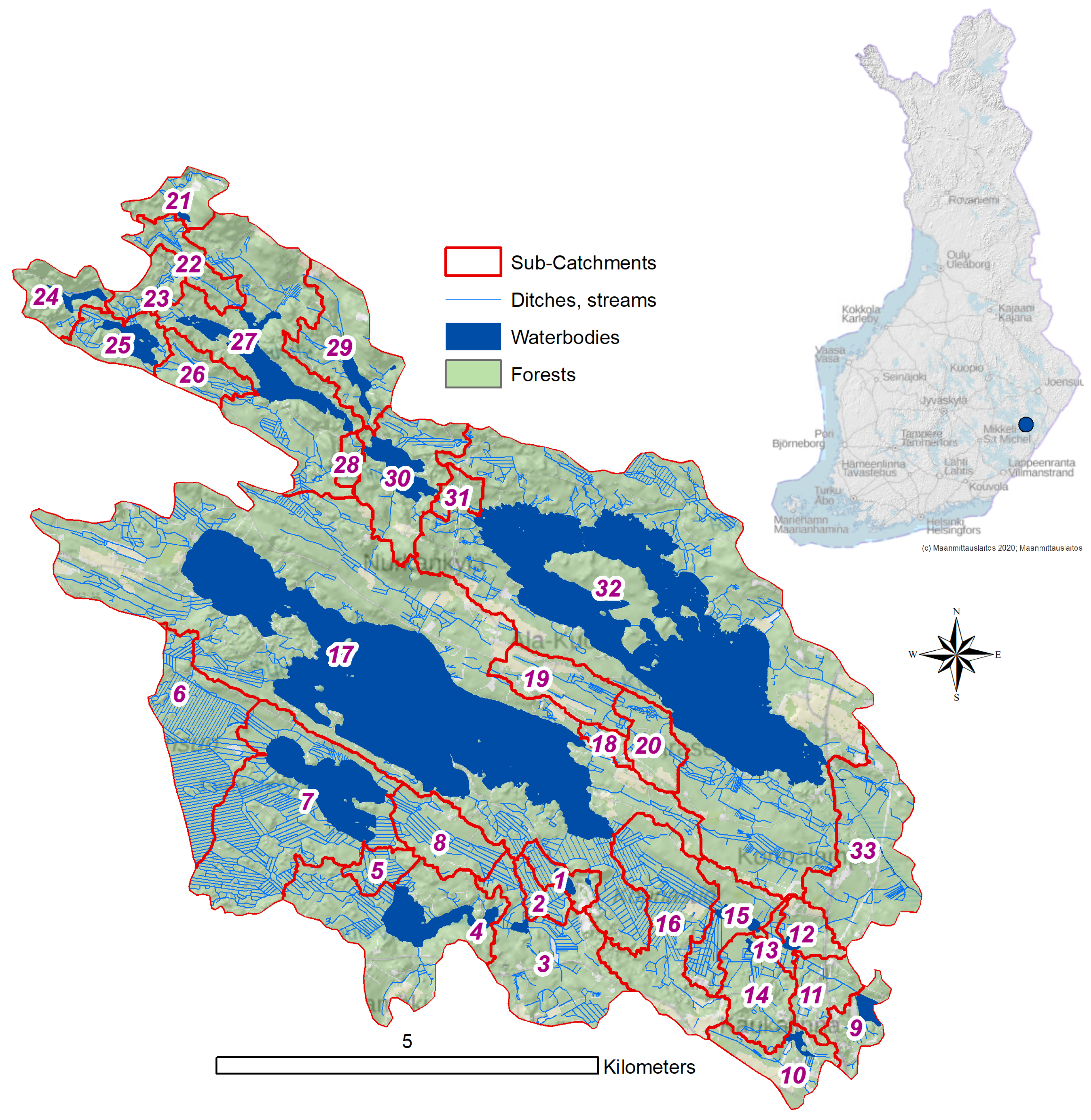
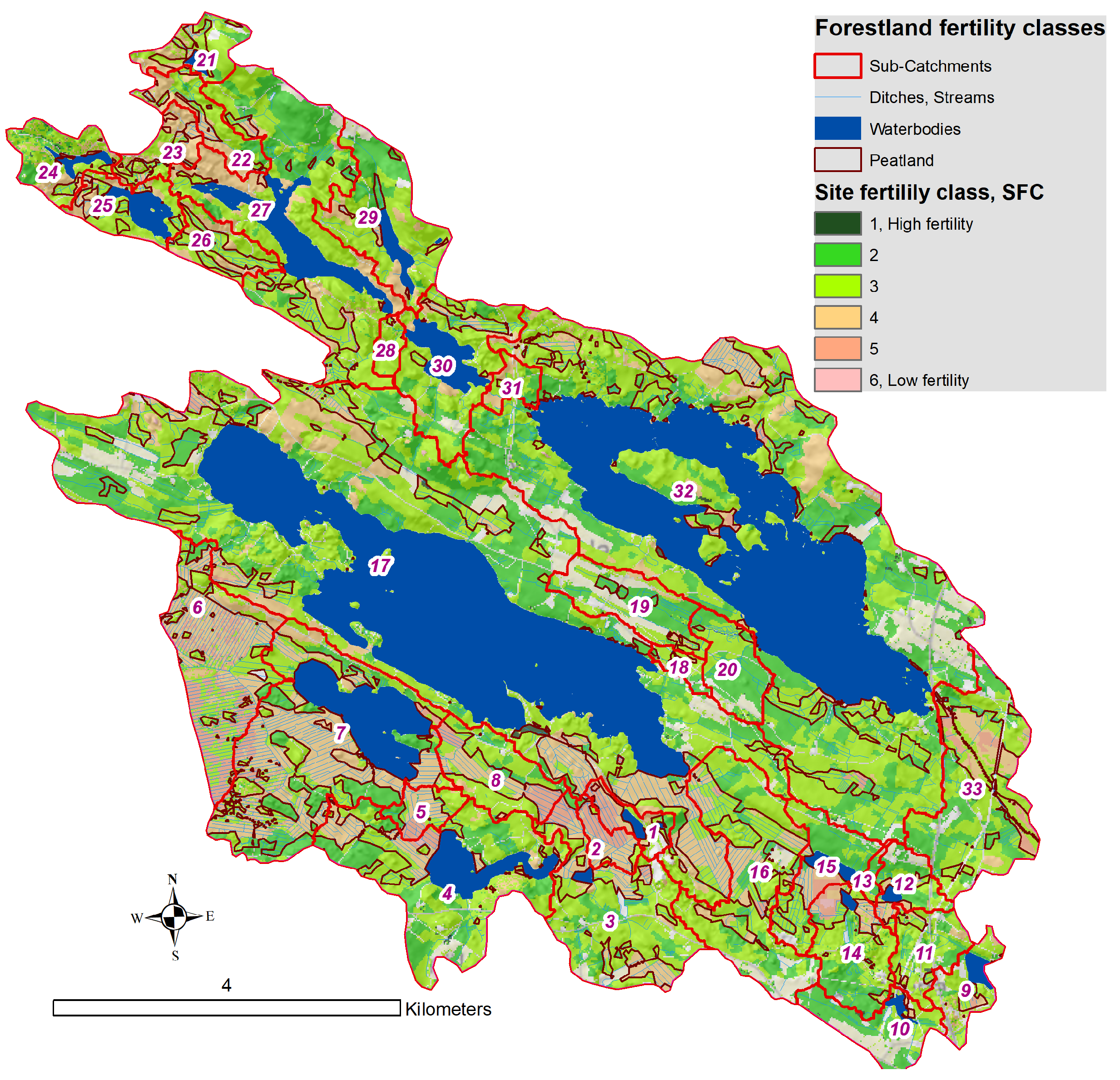
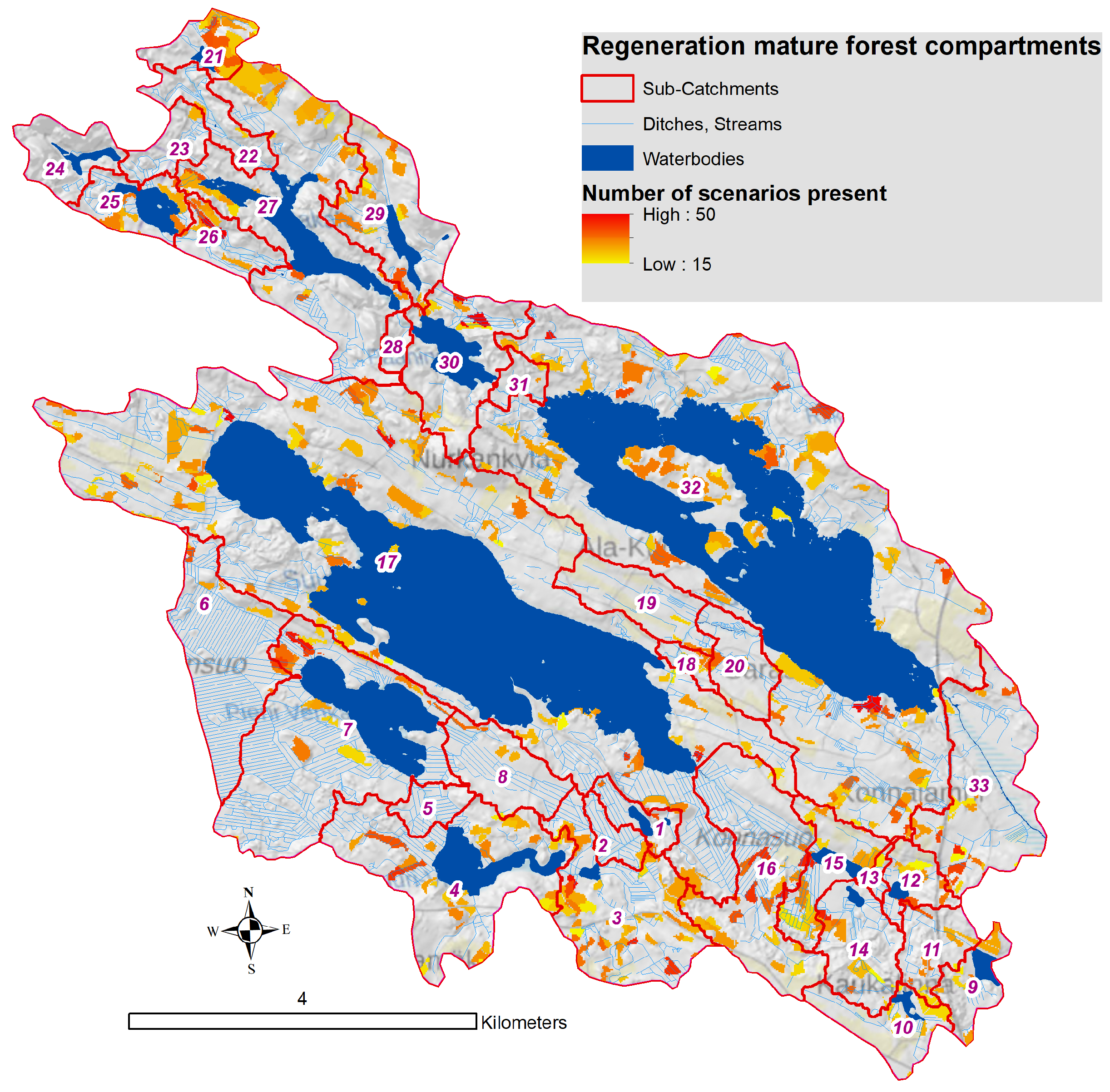

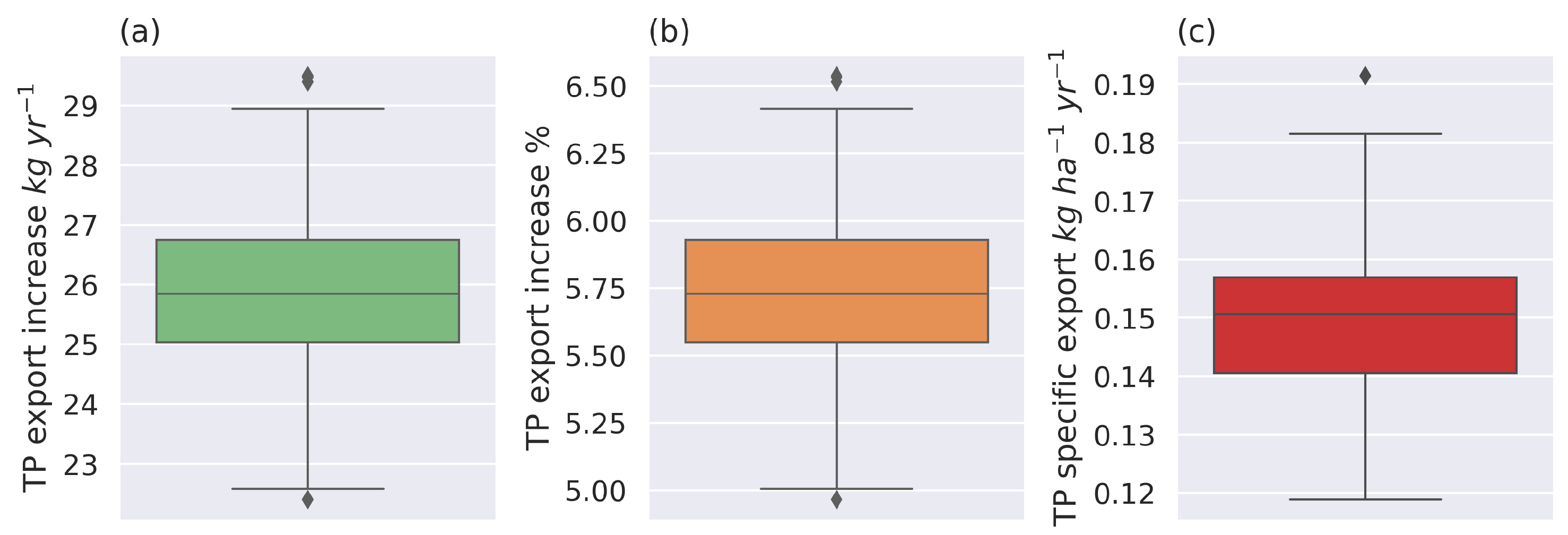

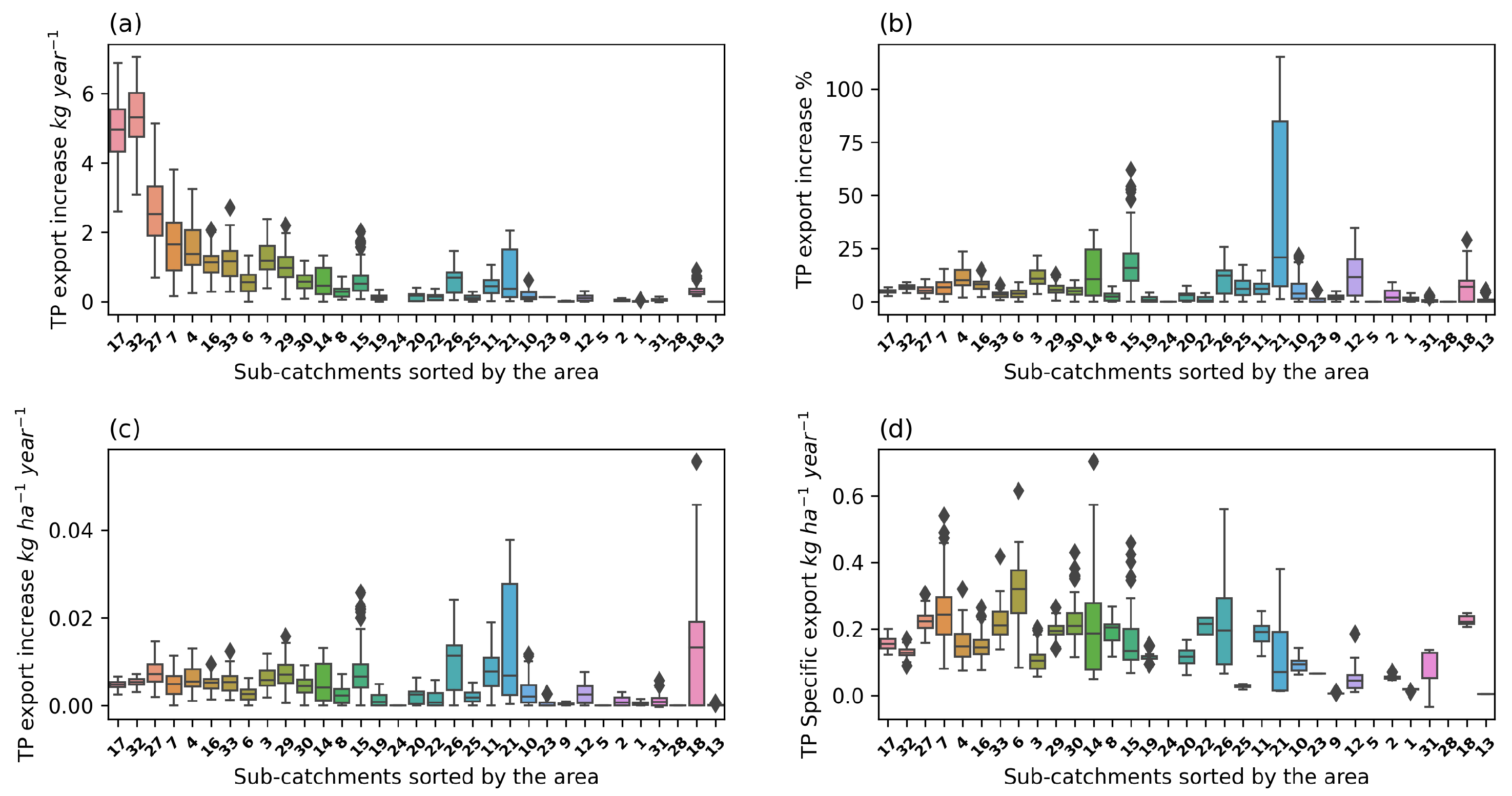
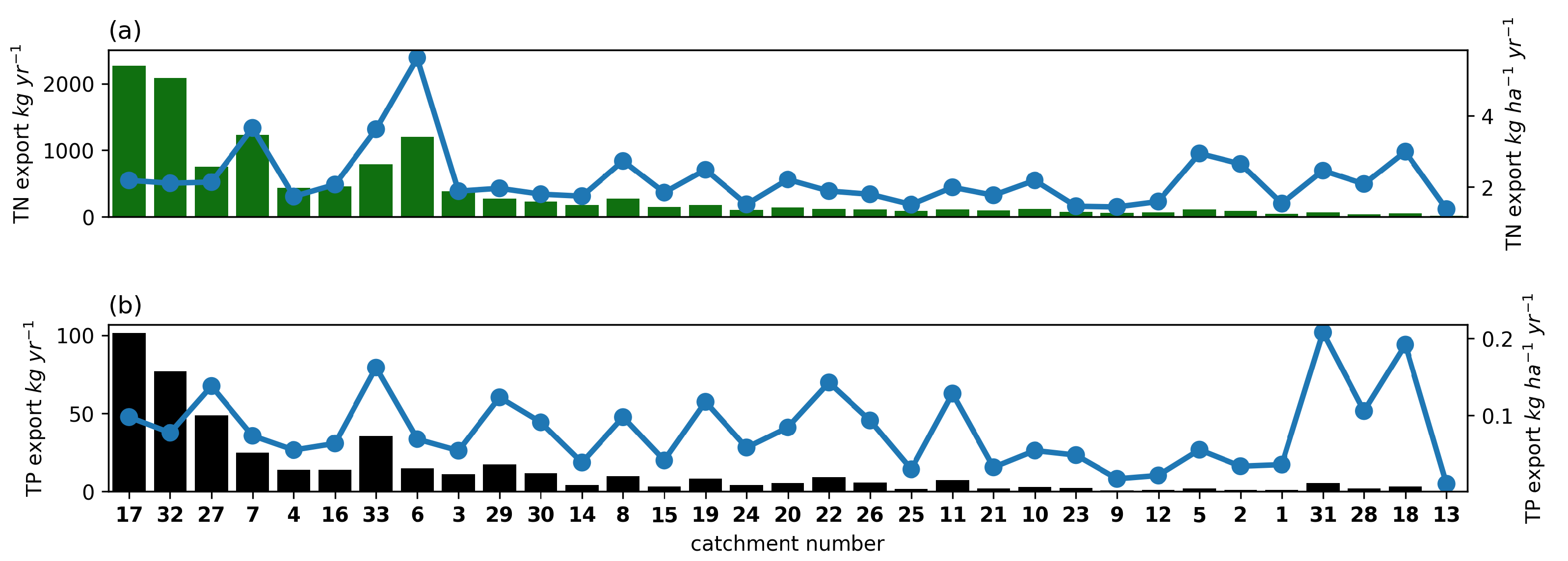

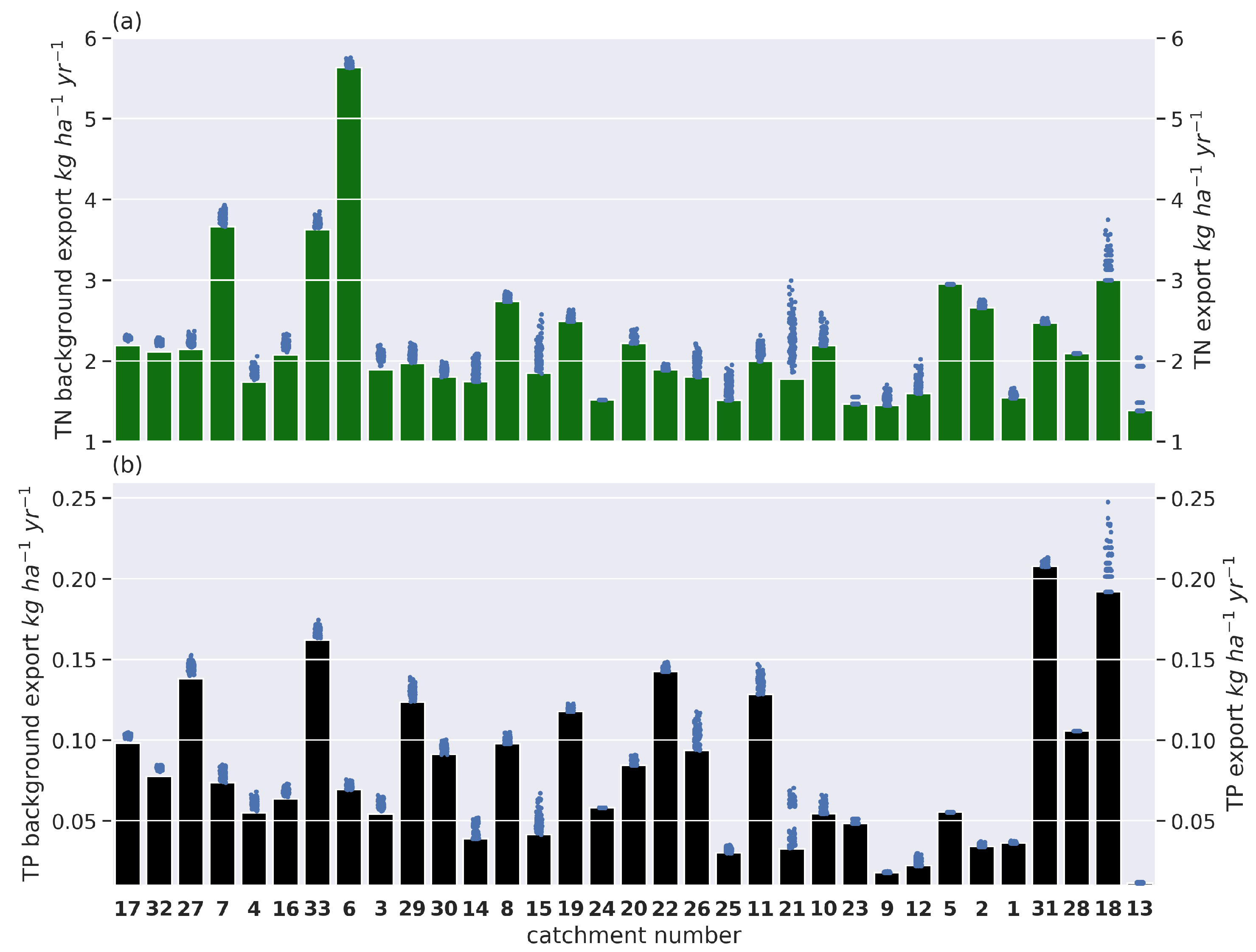

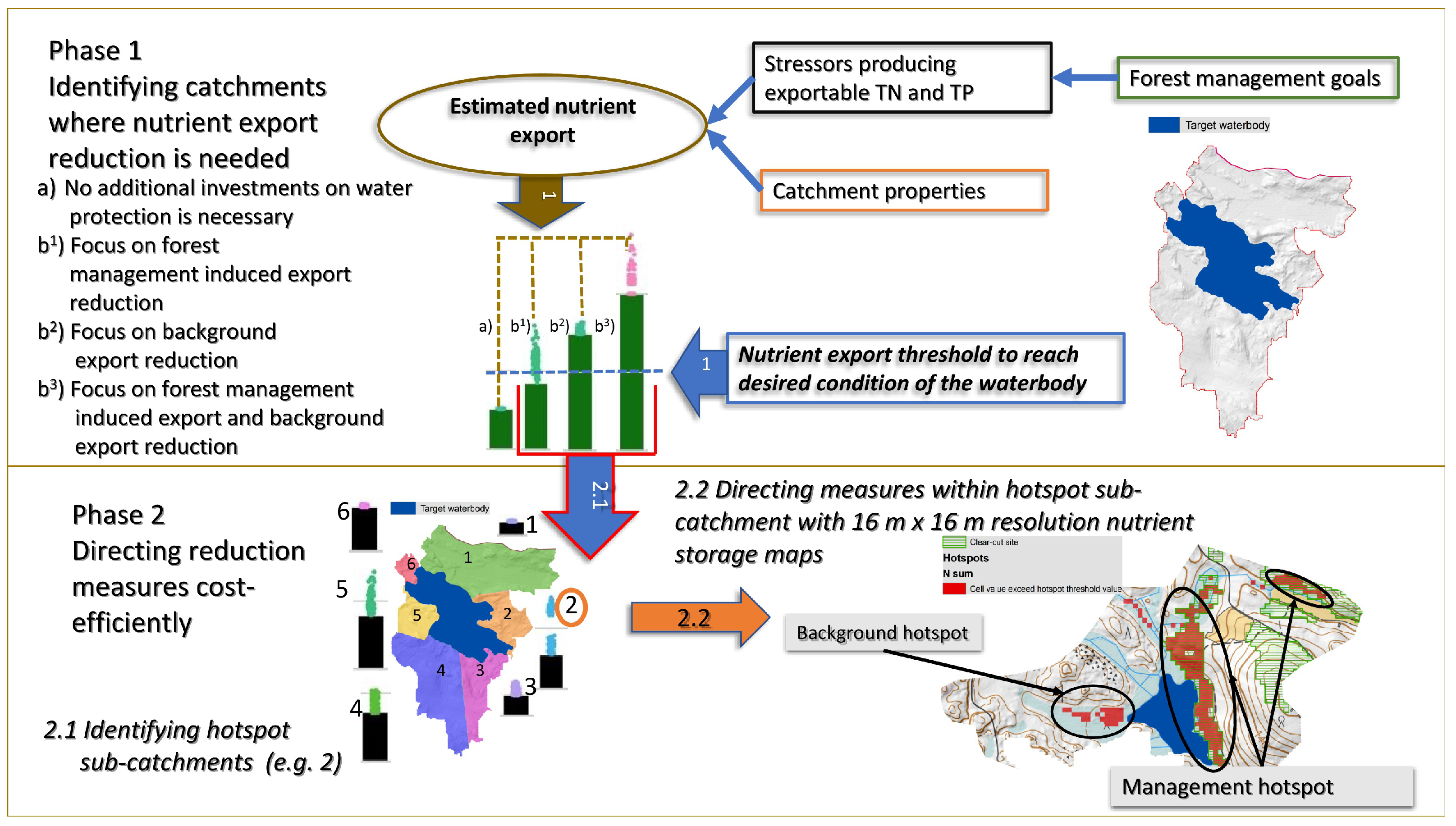
| Scenario | Clear-Cut% | TNkg catch. | TNkg hotspot | TN% | TPkg catch. | TPkg hotspot | TP% |
|---|---|---|---|---|---|---|---|
| Background 21 | 0 | 41,236 | 10,304 | 25 | 756 | 433 | 57 |
| Clear-cut 21A | 17 | 51,820 | 11,222 | 22 | 803 | 461 | 57 |
| Clear-cut 21B | 17 | 62,404 | 14,810 | 24 | 1574 | 674 | 43 |
| Background 26 | 0 | 45,830 | 11,540 | 25 | 2391 | 671 | 28 |
| Clear-cut 26A | 4 | 51,940 | 10,556 | 21 | 2738 | 739 | 27 |
| Clear-cut 26B | 2 | 51,864 | 11,089 | 21 | 2811 | 770 | 27 |
Disclaimer/Publisher’s Note: The statements, opinions and data contained in all publications are solely those of the individual author(s) and contributor(s) and not of MDPI and/or the editor(s). MDPI and/or the editor(s) disclaim responsibility for any injury to people or property resulting from any ideas, methods, instructions or products referred to in the content. |
© 2023 by the authors. Licensee MDPI, Basel, Switzerland. This article is an open access article distributed under the terms and conditions of the Creative Commons Attribution (CC BY) license (https://creativecommons.org/licenses/by/4.0/).
Share and Cite
Leinonen, A.; Salmivaara, A.; Palviainen, M.; Finér, L.; Peltola, H.; Laurén, A. Identifying Nutrient Export Hotspots Using a Spatially Distributed Model in Boreal-Forested Catchments. Forests 2023, 14, 612. https://doi.org/10.3390/f14030612
Leinonen A, Salmivaara A, Palviainen M, Finér L, Peltola H, Laurén A. Identifying Nutrient Export Hotspots Using a Spatially Distributed Model in Boreal-Forested Catchments. Forests. 2023; 14(3):612. https://doi.org/10.3390/f14030612
Chicago/Turabian StyleLeinonen, Antti, Aura Salmivaara, Marjo Palviainen, Leena Finér, Heli Peltola, and Annamari Laurén. 2023. "Identifying Nutrient Export Hotspots Using a Spatially Distributed Model in Boreal-Forested Catchments" Forests 14, no. 3: 612. https://doi.org/10.3390/f14030612
APA StyleLeinonen, A., Salmivaara, A., Palviainen, M., Finér, L., Peltola, H., & Laurén, A. (2023). Identifying Nutrient Export Hotspots Using a Spatially Distributed Model in Boreal-Forested Catchments. Forests, 14(3), 612. https://doi.org/10.3390/f14030612






